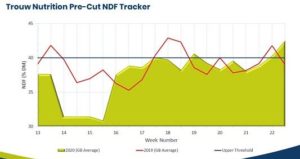Compared to last week, there is 4.8kg DM/kg/day increase to average 52kg DM/kg/ha. The largest increase of 27kg DM/ha/day and overall highest growth rates of 75kg DM/kg/day were seen in Scotland. The lowest growth rates seen in the South East of 37kg DM/kg/day, with the largest reduction of -6kg DM/ha/day!
Potential MYFG has decreased from last week’s average of M+16.33 litres/day, to an average of M+12.9 litres/day. For the same time last year, this is M+2.63 litres/day less and is much closer to the 6-year average of M+13.3 litres/day. Poorer grass growth rates has resulted decreased potential DM intakes to 12.22kg/day (-1.14kg/day on the week).
*Please take into consideration the MYFG figures as a few samples were received in the lab, where 66% of these were from Wales and the West.
Butterfat Factors
As with previous weeks of GrassWatch, butterfats remain a key focus. To mitigate the risk of butterfat depressions, optimizing rumen function is essential. Rumen pH is compromised from the low fibre and high sugar content in the grass, increasing the rate which is passed through the digestive tract. This combined with higher oil levels results in an increased risk of not only butterfat depression but also acidosis.
Low levels at 175 are being reported for fibre index, indicating that rumination rates and cud-chewing will be compromised and therefore compromise her ability to buffer the rumen with her saliva. To increase the risk of acidosis further, high levels of RFC have been reported at 195g/kg DM and acid loads at 41.
Providing fibrous forage around milking, as a buffer, can increase the production of saliva, which can help mitigate acidosis risk. Another way to help with butterfat and acidosis risk, is to supplement the diet with yeasts and rumen buffers.
Heat Stress
The increased temperatures have also seen the increase in humidity index towards the upper limits for milk heat stress. With forecasted predicting weather to be warm and sunny, it is important to implement management practices to reduce the risk of heat stress. Consistent and adequate access to clean, freshwater, and access to shade are key!
Pre-Cut NDF Development
Average NDF content of 42.5% was reported in the final report for the 2020 period. This indicates that quality will be compromised, as the optimum threshold is 38-40%. Although this is the last report for NDF development for 2020, submission of samples from any remaining first cut crops are encouraged, as values will differ between farms and fields.

